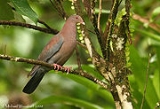
Red-billed Pigeon
Encyclopedia
The Red-billed Pigeon, Patagioenas flavirostris (see Johnson et al. 2001), is a relatively large pigeon
which breeds from southern Texas
, United States
, and northwestern Mexico
south to Costa Rica
. It belongs to a clade
of Patagioenas which generally lack iridescent display plumage, except some vestiges in the Pale-vented Pigeon
.
It is found in open country with some trees, large clearings and cultivation in lowlands and middle altitudes to 2100 meters. It builds a rudimentary platform nest out of twigs in a tree about 4–25 m (13.1–82 ft) above the ground, usually on a horizontal branch or on a palm
crown, and lays one white egg.
The Red-billed Pigeon is mid or large-sized pigeon, at 30–37 cm (11.8–14.6 in) in length and a weight of 230–425 g (8.1–15 oz). It is mainly wine-purple, becoming browner on the back, and with a grey tail, lower belly and flight feathers. The bill is white with a red base, and the legs and eyes are red. Juvenile birds are duller than adults and the plumage is brown-tinged.
It is normally seen alone or in pairs and rarely forms flocks. It feeds on the ground, seeking acorns, berries and buds.
The Red-billed Pigeon has a loud kuk c'c'coooo call that is given in rows; the initial short kuk is characteristic for this group of Patagioenas (Mahler & Tubaro 2001).
Dove
Pigeons and doves constitute the bird family Columbidae within the order Columbiformes, which include some 300 species of near passerines. In general terms "dove" and "pigeon" are used somewhat interchangeably...
which breeds from southern Texas
Texas
Texas is the second largest U.S. state by both area and population, and the largest state by area in the contiguous United States.The name, based on the Caddo word "Tejas" meaning "friends" or "allies", was applied by the Spanish to the Caddo themselves and to the region of their settlement in...
, United States
United States
The United States of America is a federal constitutional republic comprising fifty states and a federal district...
, and northwestern Mexico
Mexico
The United Mexican States , commonly known as Mexico , is a federal constitutional republic in North America. It is bordered on the north by the United States; on the south and west by the Pacific Ocean; on the southeast by Guatemala, Belize, and the Caribbean Sea; and on the east by the Gulf of...
south to Costa Rica
Costa Rica
Costa Rica , officially the Republic of Costa Rica is a multilingual, multiethnic and multicultural country in Central America, bordered by Nicaragua to the north, Panama to the southeast, the Pacific Ocean to the west and the Caribbean Sea to the east....
. It belongs to a clade
Clade
A clade is a group consisting of a species and all its descendants. In the terms of biological systematics, a clade is a single "branch" on the "tree of life". The idea that such a "natural group" of organisms should be grouped together and given a taxonomic name is central to biological...
of Patagioenas which generally lack iridescent display plumage, except some vestiges in the Pale-vented Pigeon
Pale-vented Pigeon
The Pale-vented Pigeon, Patagioenas cayennensis, is a large pigeon found in the tropical American. Formerly often placed in Columba, it actually belongs to a clade of the older New World genus Patagioenas. With its relatives it represents an evolutionary radiation extending through most of the...
.
It is found in open country with some trees, large clearings and cultivation in lowlands and middle altitudes to 2100 meters. It builds a rudimentary platform nest out of twigs in a tree about 4–25 m (13.1–82 ft) above the ground, usually on a horizontal branch or on a palm
Arecaceae
Arecaceae or Palmae , are a family of flowering plants, the only family in the monocot order Arecales. There are roughly 202 currently known genera with around 2600 species, most of which are restricted to tropical, subtropical, and warm temperate climates...
crown, and lays one white egg.
The Red-billed Pigeon is mid or large-sized pigeon, at 30–37 cm (11.8–14.6 in) in length and a weight of 230–425 g (8.1–15 oz). It is mainly wine-purple, becoming browner on the back, and with a grey tail, lower belly and flight feathers. The bill is white with a red base, and the legs and eyes are red. Juvenile birds are duller than adults and the plumage is brown-tinged.
It is normally seen alone or in pairs and rarely forms flocks. It feeds on the ground, seeking acorns, berries and buds.
The Red-billed Pigeon has a loud kuk c'c'coooo call that is given in rows; the initial short kuk is characteristic for this group of Patagioenas (Mahler & Tubaro 2001).

